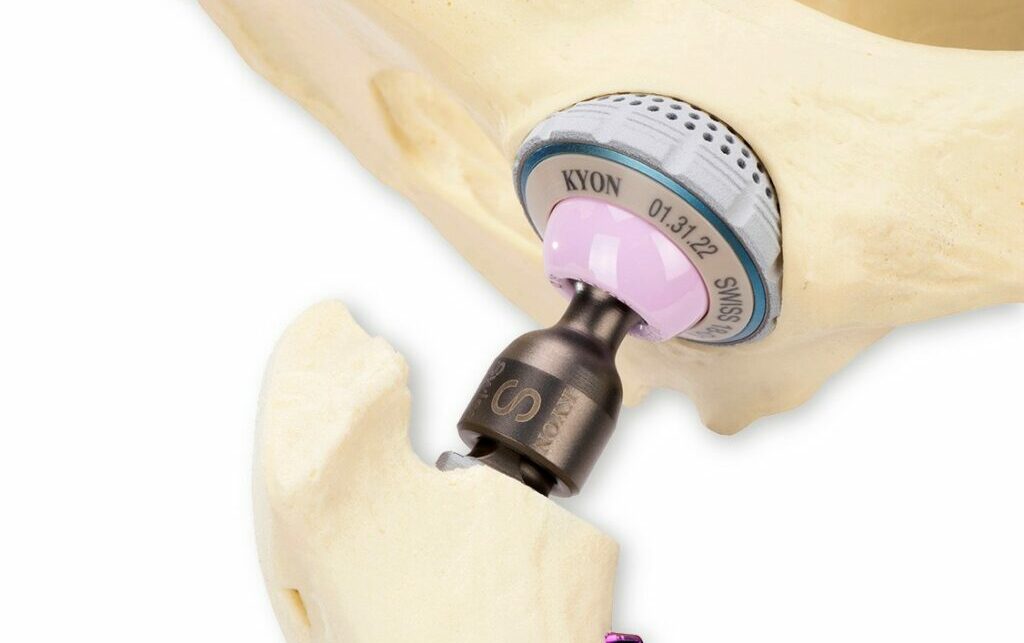It’s amazing to think that surgeons have been performing total hip replacements (THRs) in dogs for over 40 years (and I’ve been performing them for 20 years, which makes me feel very old!). As you would expect, over that time canine THR has evolved, much like it has in human surgery.
To cement or not to cement?
The original total hip replacements, in man and dogs, were all cemented, with cementless systems starting to become available towards the end of the 1990s. Whether cement or cementless is better remains a contentious issue in human orthopaedics with some fierce tribal loyalties for each method of fixation.
The use of cement in hip replacements is still common in older patients who may have lower activity levels and are less concerned about the lifespan of the implant. However, it would be very uncommon for a younger, more active individual to undergo a cemented THR. When it comes to our canine and feline patients, although their lifespans are shorter than ours, the forces exerted on their implants are likely much higher relative to the size of the implant compared to a typical human THR patient. It’s important to remember that our canine and feline patients behave like miniature athletes. They don’t lead sedentary lifestyles like many human THR patients do. We expect our pets to regain full activity levels following a THR, which often involves plenty of running and jumping.
Cement failure
One of the primary concerns regarding cement in hip replacements is the potential for even the slightest instability between the cement mantle and the implant to result in the generation of cement wear particles. These, combined with wear particles from the cup liner, have the ability to induce cell-mediated loss of the bone-cement interface. This process can escalate from micro instability to gross instability, ultimately leading to clinical failure of the total hip replacement. In comparison, while cementless implants can also experience instability, the reasons for such instability are often different, and the revision process is typically easier.
Cementless benefits
My preference is to perform cementless total hip replacement where practical, with my personal preference being the Kyon Zurich THR system. Up until recently cementless systems were only available for larger dogs (>20kg) with smaller dogs and cats only having cemented THR as an option. Of course implant evolution continues and it’s great to see mini cementless systems starting to become available for our patients, although we don’t yet have long-term data on their outcomes.
Feline total hip replacement
So which patients benefit from total hip replacement? In short, any patient – canine or feline – with chronic or intractable hip pain. Most canine patients have underlying hip dysplasia. Cats can also suffer from hip dysplasia but the most common indication for THR in cats is slipped capital femoral epiphysis (SCFE). As I write this, I can hear some of you saying, “But cats do fine with a femoral head and neck excision!”. I agree, they can do ‘OK’, but having lived with a cat with a THR and with a FHNE I can tell you that in my experience THR results in a much more active and happier cat.
I have been a part of the BVOA/University of Liverpool Hip Registry since its inception and we have published a number of papers with the registry data, including one on feline THRs which showed complication rates broadly similar to canine THR and a high owner satisfaction rate.
Recent advances
As well as cementless mini total hip replacement systems, other recent Kyon THR advances include the adoption of ceramic heads and PEEK cups. PEEK has better wear properties than traditional polyethylene cups and ceramic has a lower coefficient of friction than metal for the bearing surface. There is also a dual-mobility cup designed for dogs at higher risk of luxation, such as larger breed dogs.
Over the past 20 years I have performed hundreds of THRs, but recently I was lucky enough to visit a clinic in Italy where one surgeon has performed more than 4000 THRs. No one has performed more canine THRs than Aldo Vezzoni, who also uses the Kyon Zurich THR system. It was a fantastic learning experience and I am looking forward to bringing some of Aldo’s tips and tricks to The Moores Orthopaedic Clinic.
Andy Moores is one of the most qualified and experienced small animal orthopaedic surgeons in the UK. He has been a referral-only orthopaedic surgeon for over 20 years, an EBVS Specialist for 17 years and an RCVS Specialist for 16 years. He has treated thousands of cats and dogs with orthopaedic problems during this time. This experience is now available to your clients and patients at The Moores Orthopaedic Clinic. If you would like to discuss a case or make a referral then you can contact Andy directly via andy@mooresortho.com. You can subscribe to our newsletter and be informed of future blogs and articles at www.mooresortho.com



